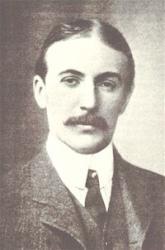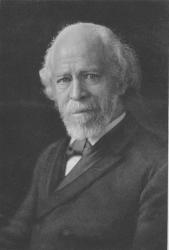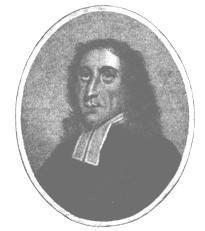Planning worship?
Check out our sister site, ZeteoSearch.org,
for 20+ additional resources related to your search.
- |
User Links
Person Results
E. E. Hewitt

1851 - 1920 Person Name: Eliza E. Hewitt Meter: 10.10.12.10 Author of "God Will Take Care Of Me" in The Cyber Hymnal Pseudonym: Lidie H. Edmunds.
Eliza Edmunds Hewitt was born in Philadelphia 28 June 1851. She was educated in the public schools and after graduation from high school became a teacher. However, she developed a spinal malady which cut short her career and made her a shut-in for many years. During her convalescence, she studied English literature. She felt a need to be useful to her church and began writing poems for the primary department. she went on to teach Sunday school, take an active part in the Philadelphia Elementary Union and become Superintendent of the primary department of Calvin Presbyterian Church.
Dianne Shapiro, from "The Singers and Their Songs: sketches of living gospel hymn writers" by Charles Hutchinson Gabriel (Chicago: The Rodeheaver Company, 1916)
E. E. Hewitt
I. Allan Sankey

1874 - 1915 Person Name: Ira Allan Sankey Meter: 10.10.12.10 Composer of "OLD ORCHARD" in The Cyber Hymnal Ira Allan Sankey, 1874-1915
Born: August 30, 1874, Edinburgh, Scotland.
Died: December 30, 1915, United States.
Son of Ira Sankey, Allen studied civil engineering and architecture at Princeton University, graduating in 1897. In 1898, he became president of the Biglow & Main music publishers in New York City. He also served as vice-president of the Leeds and Catlin Phonograph Company, and on the Advisory Board of the Greenich Bank.
His works include:
The Male Quartette, with George Stebbins
Best Endeavor Hymns, with John Clements (New York: The Biglow & Main Co., 1907)
Hallowed Hymns, New and Old (Chicago, Illinois: The Biglow & Main Co., 1908)
Sources--
Hall, pp. 409-410
Music--
Cidenton
Go and Work!
Great Is His Mercy
Kept for Jesus
Lead Me
Lord, Send Us Forth
Never Give Up
Old Orchard
Year of Precious Blessings, A
--hymntime.com/tch
I. Allan Sankey
Charles Gordon Ames

1828 - 1912 Person Name: Charles G. Ames, 1828-1912 Meter: 10.10.12.10 Author of "Father in Heaven, Hear Us Today" in The Cyber Hymnal Ames, Charles Gordon. (Dorchester, Massachusetts, 1828-April 15, 1912, Boston, Massachusetts). He was ordained as a Baptist minister in 1849 and spent some years as a home missionary in Minnesota. In 1859, he joined the Unitarian denomination and served several churches, his last pastorate being with the Church of the Disciples, Boston. In 1905, he wrote a hymn for the dedication of the new edifice of that Society, beginning "With loving hearts and hands we rear," which is included in The New Hymn and Tune Book, 1914. A hymn beginning "Father in heaven, hear us today," is attributed to him in the Universalist Church Harmonies: Old and New, 1898, but is not found elsewhere.
--Henry Wilder Foote, DNAH Archives
Charles Gordon Ames
Eliza M. Sherman
Meter: 10.10.12.10 Author of "சாஷ்டாங்கமாகவே, வீழ்ந்தேனிப்போ" in The Cyber Hymnal
Eliza M. Sherman
Hubert P. Main

1839 - 1925 Person Name: Hubert Platt Main Meter: 10.10.12.10 Composer of "SAITAMA" in The Cyber Hymnal Hubert Platt Main DD USA 1839-1925. Born at Ridgefield, CT, he attended singing school as a teenager. In 1854 he went to New York City and worked as an errand boy in a wallpaper house. The next year he became an errand boy in the Bristow & Morse Piano Company. He was an organist, choir leader, and compiled books of music. He also helped his father edit the “Lute Songbook” by Isaac Woodbury. In 1866 he married Olphelia Louise Degraff, and they had two sons: Lucius, and Hubert. In 1867 he filled a position at William B Bradbury’s publishing house. After Bradbury’s death in 1868 the Bigelow & Main Publishers were formed as its successor. He also worked with his father until his father’s death in 1873. Contributors to their efforts were Fanny Crosby, Ira Sankey, Wilbur Crafts, and others. In addition to publishing, Main wrote 1000+ pieces of music, including part song, singing school songs, Sunday school music, hymns, anthems, etc. He also arranged music and collected music books. He 1891 he sold his collection of over 3500 volumes to the Newberry Library in Chicago, IL, where they were known as the Main Library. Some of his major publications include: “Book of Praise for the Sunday school” (1875), “Little pilgrim songs” (1884), “Hymns of Praise” (`1884), “Gems of song for the Sunday school” (1901), “Quartettes for men’s voices: Sacred & social selections” (1913). In 1922 Hope Publishing Company acquired Bigelow & Main. He was an editor, author, compiler, and composer, as well as publisher. He died in Newark, NJ.
John Perry
Hubert P. Main
Samuel Wesley

1691 - 1739 Person Name: Samuel Sebastian Wesley Meter: 10.10.12.10 Composer of "ST. MICHAEL NEW" in The Cyber Hymnal Samuel Wesley, M.A., the younger, was the eldest child of Samuel and Susanna Wesley, and was born in or near London in 1691. He received his early education from his mother, who always took a special interest in him as her firstborn. In 1704 he went to Westminster School, where he was elected King's Scholar in 1707. Westminster had, under the mastership of Dr. Busby for 55 years, attained the highest reputation for scholarship, and Samuel Wesley, as a classical scholar, was not unworthy of his school. In 1709, Dr. Spratt, Bishop of Rochester, patronised the young scholar, and frequently invited him to Bromley. In 1711 he went with a Westminster studentship to Christ Church, Oxford, and having taken his degree, returned to Westminster as an Usher. He then received Holy Orders and became an intimate friend of Bishop Atterbury, who was then Dean of Westminster. His intimacy with this prelate was a bar to his advancement, and he was bitterly disappointed at not being appointed undermaster at Westminster when that post was vacant. But he was faithful to his friend in his adversity, and the banished prelate warmly appreciated his attachment. In 1732 he was invited, without solicitation, to accept the headmastership of the Free School at Tiverton, and here he spent the remainder of his life. He strongly disapproved of John and Charles Wesley's proceedings; but though the brothers expressed their opinions to one another with characteristic frankness, the disagreement did not cause any interruption in the friendly relations between them.
Samuel Wesley was universally acknowledged to be an honest, conscientious and deeply religious man. He was a most uncompromising High Churchman both in the political and the theological sense of that term; and there is no doubt that he was the mainstay of the Wesley family at Epworth. His kindness to his father and mother was unbounded, and he acted like a father to his younger brothers and sisters. He also took a great interest in works of charity, and was one of the first promoters of the Westminster Infirmary. He died at Tiverton in the 49th year of his age, Nov. 6, 1739. His epitaph in Tiverton Churchyard does not exaggerate his merits, when it describes him as—
"a man for his uncommon wit and learning, For the benevolence of his temper, and simplicity of manner, Deservedly loved and esteemed by all: An excellent Preacher; But whose best sermon Was the constant example of an edifying life: So continually and zealously employed In acts of beneficence and charity, That he truly followed His blessed Master's example In going about doing good; Of such scrupulous integrity, That he declined occasions of advancement in the world, Through fear of being involved in dangerous compliances; And avoided the usual ways to preferment As studiously as many others seek them."
Samuel Wesley published in 1736 A Collection of Poems on several occasions, some of which are full of a rather coarse humour, but all of a good moral and religious tendency. This work was reprinted in 1743, and again by W. Nichols in 1862. Dr. Adam Clarke specifies eight hymns of S. Wesley's composition which were in use among the Methodists of that time (1823). The Wesleyan Hymn Book of the present day contains five, the best-known of which is "The Lord of Sabbath let us praise."
Six of his hymns are in common use, and are annotated as follows:—
1. From whence these dire portents around.
2. Hail, Father, Whose creating call.
3. Hail, God the Son in glory crowned.
4. Hail, Holy Ghost, Jehovah, Third.
5. The Lord of Sabbath, let ns praise.
6. The morning flowers display their sweets.
-- Excerpts from John Julian, Dictionary of Hymnology (1907)
Samuel Wesley
Theodore E. Perkins

1831 - 1912 Meter: 10.10.12.10 Composer of "LUNDIE" in The Cyber Hymnal Theodore E. Perkins was born at Poughkeepsie, on the Hudson, N.Y., July 21, 1831. His father was a Baptist clergyman. The family of ten brothers and sisters sang and played various instruments, forming among themselves both choir and orchestra. His musical education began at the early age of three years. During his father's pastorate at Hamilton, N. Y., the choir rehearsals were often held at the parsonage, and the leader used to place the three-year-old on a small stool, on the table around which the choir was assembled, giving him a chance to both see and hear. Later on he played the violincello in church, standing on a stool in order to finger the instrument.
The home gatherings — especially on Thanksgiving Day, are the recollections among the happiest of his childhood. His father became pastor of the Berean Baptist Church in New York City, in 1839, giving him the opportunity of studying the pianoforte, of which he became a proficient player. His fine alto voice soon gave him notoriety. At the age of nineteen while filling a position as clerk in New York, all his spare time was given to the study of voice and piano. In 1851 he went to Hamilton, N. Y., taught music in Madison University (now Colgate), and in the Female Seminary.
In 1854 he went to Port Jervis, N. Y., where he taught singing school, and April 30, 1855, married Mary Frances Caskey, who was for years his soprano soloist in many musical Festivals and Conventions. Soon after marriage he removed to Salem, N. J., where his lifework as singing school teacher really began, including Bridgeton and prominent towns in southern New Jersey. During the summer of 1856 he and his wife were pupils of the Normal Academy of Music at North Reading, Mass., conducted by Drs. Lowell Mason and Geo. F. Root. During 1856-1858 he was given the position of assistant teacher and manager. His association with these two great men gave an inspiration to all his future work.
In 1859 he was co-principal with Wm. B. Bradbury at the Normal Academy of Music, Geneseo, N. Y. He remained at Geneseo until 1863. Professor Perkins also held very successful schools in North Pelham Province of Ontario, Canada, and in 1864-1868 was principal in schools at Tunkhannock and Meadville, Pa.
In 1860, The Olive Branch, his first book of church music, was published by F. J. Huntington, New York City, the sales reaching 100,000. Next was Oriental, which sold over 30,000. The Union, Glees and Anthems, and Sabbath Anthems followed ; then The Sacred Lute, which sold over 300,000. His Sunday-school books commenced with The Evergreen, followed by the Shining Star and New Shining Star. Then came Psalm King, which was the last of the books published by Mr. Huntington. Hallowed Songs was published by Philip Phillips; The Sunday School Banner was published by Wm. B. Bradbury. The Royal Standard was published in Toronto, Canada. The Golden Promise, Sabbath Carols, The Mount Zion Collection were published under his own supervision.
His Free Sunday School Songs several times numbered over 500,000 a month. Coronation Songs with Rev. Dr. Deems as hymn editor was published by A. S. Barnes Co., who also published Psalms and Hymns and Spiritual Songs, in which Dr. C. S. Robinson was hymn editor, who with Professor Perkins edited Calvary Songs, published by the American S. S. Union. Gospel Tent Songs was evangelical. The Safe-Guard Singer was his temperance book.
Mr. Perkins was musical director in the following churches in Brooklyn: The Lafayette Avenue Presbyterian Church, Rev. Dr. Cuyler; Strong Place Baptist Church, Rev. E. E. L. Taylor, D. D.; Madison Avenue Baptist Church, Rev. H. G. Weston, D. D., L. L. D.; Fifth Avenue Presbyterian Church, Rev. Dr. Rice, followed by Dr. John Hall; The Memorial Presbyterian Church, Rev. Dr. C. S. Robinson, who was his close friend; The Church of the Holy Trinity, Rev. Dr. Tyng, Jr. ; Trinity Baptist Church, Rev. Dr. J. B. Simmons, and Washington Square M. E. Church.
In Philadelphia: The Fifth Baptist Church, Rev. Dr. Chase; The Eleventh Baptist Church, Rev. Dr. Colman; The Tabernacle M. E. Church, Rev. George Gaul, D. D. He was leader and singer in Evangelistic Services, at the Rink, The Old Madison Square Garden and Cooper Union, all of New York City. The music of the first great meeting of the world's Evangelical Alliance, held for ten days in New York City, was under his direction, as was the first National Sunday School convention, held in Newark, N. J. He was also conductor at the Golden Anniversary of the Female Guardian Society, leading a chorus of forty-two hundred children. In the opening chorus, Great is the Lord, by Dr. Calcott, the word "Great" was given with so much decision and power that the clergymen on the platform sprang to their feet and remained standing until the chorus was finished.
He taught voice culture in Princeton and Lafayette Universities, The Union Theological Seminary, New York City; Crozer Seminary, Chester, Pa., and organized the music department of Temple University, Philadelphia, continuing in charge four years. He had charge of the children's choir of Howard Mission, New York City, for twenty-five years, and thinks that some of the happiest and most restful of the working hours were spent in teaching the poor children of the fourth and sixth wards to sing the Gospel. Mr. Sankey said to Mr. Perkins that " Jesus of Nazareth was my banner song for eight years." Jesus is Mine has been sung at the Christian's death-bed, the grave, and once as the convict was going to the scaffold.
His Christmas Carol Sweetly Carol had a very large sale in this country, and was republished in England, France, Italy, and Germany.
For a period of forty years he has made the study of the voice special work. The most thorough investigations of the voice and its possibilities were made with the assistance of the late John Howard, extending over a period of twenty-five years, during which he has had the care of over two thousand voices. He published a work entitled, Physiological Yoice Culture, edited by his son, the late T. Edward Perkins, M. D., physician and throat specialist of Philadelphia. Mr. Perkins also completed a method of voice culture based on the principles of John Howard's Physiology of Artistic Singing."
During these years of work he has found time to edit thirty-four books of church, Sunday-school, day-school, and glee music, the larger portion having been previously mentioned. Also songs and ballads in sheet form, and a cantata entitled, The Excursion, libretto by Fanny Crosby, with whom there has existed an unbroken friendship for over forty years.
-Biography of Gospel Song and hymn Writers
Theodore E. Perkins
J. B. Atchinson
1840 - 1882 Person Name: Jonathan B. Atchinson Meter: 10.10.12.10 Author of "Into Thy Service, Lord" in The Cyber Hymnal Atchinson, Jonathan Bush, born at Wilson, New York, Feb. 17, 1840, and "licensed as a Methodist Preacher," Sept. 6, 1874. Of his hymns the following are the best known:—
1. Behold the stone is rolled away. [Easter.] This was Mr. Atchinson's first hymn. It appeared in the Sunday School Times, Dec. 1874. It is not in use in Great Britain.
2. Fully persuaded, Lord, I believe. [Faith.] Written in 1874 or 1875, and first published in Gospel Hymns, No. 1. It is given in I. D. Sankey's Sacred Songs & Solos, No. 149, with music by W. F. Sherwin.
3. I have read of a beautiful city. [Heaven.] Written about the same time as the former, and published in Gospel Hymns. It is given in I. D. Sankey's Sacred Songs & Solos, No. 403, with music by O. F. Presbrey.
4. O crown of rejoicing that's waiting for me. [The Reward .] This hymn is also in I. D. Sankey's Sacred Songs & Solos, No. 174, where it is set to music by P. Bliss. [Rev. F. M. Bird, M.A.]
-- John Julian, Dictionary of Hymnology (1907)
J. B. Atchinson
Richard Lloyd
1933 - 2021 Meter: 10.10.12.10 Arranger of "BIRJINA GAZTETTOBAT ZETOEN" in Complete Anglican Hymns Old and New
Richard Lloyd


 My Starred Hymns
My Starred Hymns


